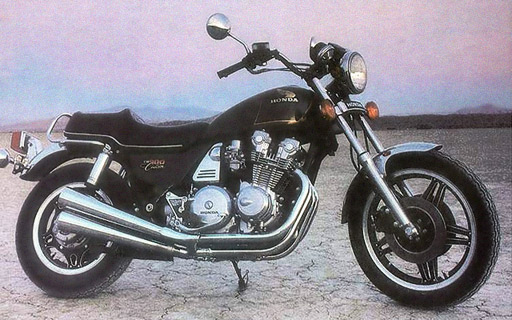Honda CB900 Custom
Mon, April 26th, 2010
IT’S HONDA WEEK!
Featuring a different Honda street bike each day.
| 1980–82 Honda CB900C/1983 CB1000C Custom | |
|---|---|
| Performance | |
| Honda needed to bring a shaft-drive cruiser to market quickly, and pieced together a stopgap design that mated a Gold Wing shaft drive to their current DOHC four. Unfortunately for them, the motor's output shaft happened to be on the opposite side of the bike from the GL's final drive unit. Honda's clumsy, inefficient solution was an extra set of gears mated to a transverse jackshaft behind the engine. To disguise this inelegant arrangement as a 'special feature,' Honda added two gear ratios and a second shift lever to create an external 'hi-lo range' secondary transmission. This convoluted, inefficient path gave the 900 shaftie little more rear-wheel power than its chain-drive CB750C twin and noticeably more driveline lash. When the CB1100F appeared on US shores for '83, performance of the ten-speed cruiser was comparatively even worse, prompting a 100cc overbore for its final year of production that really didn't make much performance difference. | |
| Handling | |
| The bizarre shaft arrangement also had an effect on handling, forcing a wheelbase almost as long as the Gold Wing's. Since the resulting slow handling left the 900 Custom best suited to the wide, 'no-surprises' turns found on Interstates, comfy-cushy air suspension was used to make a quasi-tourer out of the 900. The soft suspension robbed ground clearance and precision in tighter turns. | |
| Looks | |
| The 900 is nearly identical to the attractive two-tone CB750C, with the exception of all those clumsy bits behind the engine and a too-short-looking swingarm. The CB1000C had more attractive cast wheels, but Honda's silly chrome-tape pinstripes. | |
| Reliability | |
| The same score I gave the DOHC CB750K. The shaft is more complex and expensive to fix should it blow up, but rarely needs maintenance. | |
| Practicality | |
| The 900 was bigger, clumsier, more expensive, and more complicated than the CB750 Custom, which was itself less comfortable and less capable than the -K and -F versions. Conversely, it offered no clear advantage beyond eliminating chain lubrication. The dual-range transmission was totally unnecessary on a big street bike and turned out to be nearly useless. | |
| Desirability | |
| The CB900 Custom was an offensive marketing ploy. | |
| Overall | |
|---|---|
| The dual-range CB900 was a gimmicky attempt to legitimize compromised engineering that really existed for the benefit of the manufacturer, not the customer. It was a rare cheap shot from Honda, who routinely creates superior blank-sheet designs but doesn't seem to have the same talent for creative and effective parts-bin engineering that others (Yamaha, for example) have demonstrated. | |

